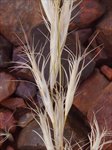
T. degreyensis spikelets.
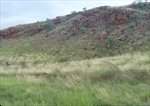
T. degreyensis habitat.
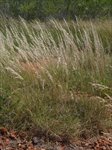
T. degreyensis plant.
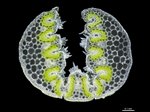
T. degreyensis leaf section.
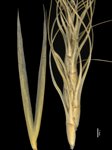
T. degreyensis glumes and spikelet.

T. degreyensis lemma bases.

T. degreyensis paleas.

T. degreyensis map.
Name
Triodia degreyensis M.D. Barrett, ined.
Citation
Nuytsia, in press, (2017)
Derivation
degreyensis — from De Grey Station, where the species occurs, and the Latin prefix –ensis, indicating origin.Common name
De Grey Spinifex
Synonyms
None
Diagnostic features
Foliage not or weakly resinous; leaf sheath surfaces glabrous; leaf blades epistomatous (soft-type); lower glume 12.4–17 mm long, narrowly lanceolate, L:W>5, 7–13-nerved; lemmas 3-lobed and 3-awned, bitextured, with dense appressed hairs all over surface in lower part; callus 0.25–0.45 mm long, acute to pungent; palea bitextured, hairy; habitat on gravelly slopes; distribution in north-east Pilbara.
Habitat
Occurs on lower slopes of low hills, amongst gravel and rocks.
Distribution and frequency
Endemic to the north-east Pilbara, where it is only known from a single range.
Similar species
Triodia degreyensis belongs to the Soft group, sharing the epistomatous (soft-type) leaf blades. Four other species (Triodia avenoides, T. basitricha, T. schinzii and T. sp. Mt Ella) in the Pilbara share the combination of epistomatous (soft-type) leaves, narrowly lanceolate glumes, awned lemma lobes and bitextured lemmas with a transverse line at maturity.
Triodia basitricha has shorter glumes 10–12.5 mm long (12.4–16 mm long in T. degreyensis) and hairs on the leaf sheath surfaces (glabrous in T. degreyensis).
Triodia avenoides and T. schinzii have glabrous paleas (hairy in T. degreyensis), a long-pungent callus 0.8–1.5 mm long (broadly acute to shortly pungent and 0.25–0.45 in T. degreyensis), glumes usually longer than the spikelet excluding awns (glumes shorter to subequal to the spikelet in T. degreyensis), and grow on sand flats and dunes (T. degreyensis on rocky or gravelly slopes).
Triodia sp. Mt Ella has shorter glumes up to 6.3–10.5(–12) mm long (12.4–16 mm long in T. degreyensis), 3–5 glume nerves (7–13 nerves in T. degreyensis), and is copiously resinous (not or weakly resinous in T. degreyensis).
Triodia melvillei and T. pisoliticola share epistomatous (soft-type) leaves and awned lemmas, but have uniformly textured lemmas and lack a transverse line on the lemma.
Triodia karijini and T. veniciae have epistomatous (soft-type) leaves and narrowly lanceolate glumes, but the lemma lobes are long-acute to sub-awned, and lemmas are uniformly textured and lack a transverse line; both species occur well south of the known range of T. degreyensis.
Conservation status
Priority One recommended.
Identification without florets
Only two species with long (>12 mm), narrowly lanceolate glumes occur in the north-east Pilbara, T. schinzii and T. degreyensis. The two species can be distinguished by substrate (T. schinzii on sand, T. degreyensis on gravel or stony slopes), inflorescence height (up to 1 m in T. degreyensis, (0.6–)1.2–2.1 m in T. schinzii), and often by glume length (12.4–17 mm in T. degreyensis, 12–32 mm in T. schinzii; in the vicinity of T. degreyensis populations, T. schinzii always has glumes >17 mm long).
Variation
No significant variation known.
Notes
The related species T. schinzii occurs immediately adjacent to the only known population of T. degreyensis, but grows on red sand rather than stony gravel.
DNA sequences indicate a relationship with T. avenoides, which occurs on sand in the west Pilbara, but morphologically it is most similar to T. bitextura. Triodia bitextura as currently circumscribed occurs across northern Australia from the West Kimberley to Queensland, and has several forms, some of which may eventually be described as distinct taxa.
Triodia degreyensis was not represented in Lazarides (1997), Lazarides et al. (2005) or Ausgrass (Sharp & Simon, 2002; Simon & Alonso, 2014). A full description of T. degreyensis can be found in Barrett (2017b).